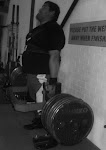Are you fit to train? - The importance of G.P.P
As athletes we are always chasing numbers, be it trying to increase our lifts or reducing our times. Most of us spend countless hours perfecting technique, looking for exercise variations and keeping ourselves abreast of the latest developments in training programmes to improve our performance – all good stuff.
You don’t have to be Albert Einstein to understand if you can increase your work capacity and the quality of that work, you will enhance performance. However what we often neglect within our training regime is to dedicate time to get our bodies conditioned aerobically, anaerobically and physically to enable us to increase our training capacity either by way of volume or intensity.
This specific area of training has been labelled as General Physical Preparedness and is referred to in most writings as its acronym, G.P.P.
In addition to helping increase work capacity G.P.P will also give you longevity in the weight room; it’s the old adage ‘Prevention is better than cure”.
Exhibit A
When it comes to explosive strength one of our younger members at the Muscle Pit is in a league of his own, summed up he is the strongest kid I’ve ever meet.
He has enormous natural potential and has had the opportunity to pursue excellence in several sports. However those doors are rapidly closing as he gets older.
Weighing in at over 150Kg he carries a lot of excess weight however he has never felt the need to get his body better prepared & conditioned for his work-outs.
While he was powerlifting, his argument was “my lifts at comp time take less than a minute and the rest between each attempt is at least 5 minutes, besides, my numbers are still improving”.
Hard to argue against, – except equipment manipulation with natural ability will only go so far.
His work-outs would consist of one set of lifts, talk for 10 minutes till fully recovered, proceed to next set, fully recover & repeat. Very seldom would he up the tempo or increase his training volume and extend himself.
I hope for his sake as he gets older he doesn’t suffer any major injuries that keep him from training that could of been prevented with better G.P.P.
Where G.P.P. could have helped
Apart from setting a good base for long term longevity in the weight room, G.P.P could have immediately benefited his deadlift which by the way is his worst lift.
The deadlift is performed last on competition day when the lifter is most fatigued. Supportive equipment for the deadlift does not assist the lifter to the same degree as the squat and bench press, meaning that the lifter cannot rely on anything but pure strength.
He would regularly deadlift more in the gym fresh, than on the competition platform.
In addition he regularly picked up small niggly injuries that G.P.P could have played a role in preventing.
How much better could he of been had he improved his G.P.P and increased his work capacity?
It’s hard to put a number on it; however it would have helped immensely. More importantly it would have set a solid foundation for any sporting pursuit he chose.
If you are striving to be the best I feel you should look under every stone.
Incorporating G.P.P
Most of us at Muscle Pit incorporate G.P.P into our schedule with three goals in mind. The first being to raise work capacity; the second to aid in helping the muscles recover quicker between weight training sessions and the third is to develop any lagging muscle groups.
We use two methods of G.P.P work to raise our work capacity at Muscle Pit. The first is our weekly “Frontline” course; this course incorporates aerobic & anaerobic conditioning, plyometrics, agility and compound movements. It’s a ball breaker; however “the crew” find it enjoyable as it breaks up our weekly routine, gets us working more as a team and in some sadistic way we enjoy watching each other suffer.
You can check it out on our YouTube site by clicking the following link:
http://www.youtube.com/watch?v=oQHlLkj1HcA
The 2nd is by dragging sleds in a variety of ways. Sled work has no eccentric or "negative" movement. The non eccentric work will induce less muscle soreness and help to aid recovery by pumping fresh blood into the targeted area. Plus it helps to condition the joints.
Because of work schedules we normally do this training before or after our work-out sessions, some will also do it on our non-training days or 12 hours after their last training session.
We generally drag the sled over approximately 100m for each exercise.
Here are a couple of sled drag variations
http://www.youtube.com/watch?v=0hIhRl8WdGM&feature=channel_page
http://www.youtube.com/watch?v=IBdZ_b2wTLA&feature=channel_page
Summary
Like breast implants, Pamela Anderson & most guys right hand, G.P.P and work capacity also go hand in hand.
Think of it like building a pyramid, the larger the base (foundation) the higher you can build. Same with athletic performance, the more volume of training your body can handle the more progress you can make - which in turn will improve your numbers.
So the question is “Are you doing everything that is needed for continual improvement and like the pyramids will you stand the test of time in the weight room?”
Subscribe to:
Post Comments (Atom)


No comments:
Post a Comment